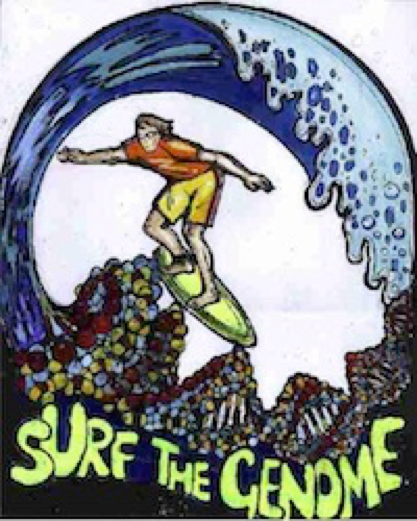In the late 1990s and early 2000s, new technologies were allowing biologists to generate massive amounts of data, but such data could be messy, and taking advantage of it demanded new quantitative tools. Statistical physics was a mature field, rich with ideas for making complex systems tractable by describing their features in aggregate. Statistical physicists realized they had powerful concepts and tools at their disposal but needed an education in biology. The two communities had much to offer each other but to bridge academic cultures they needed to learn each other’s languages.
 The design for the 2001 INFOBIO Program logo was created by Olga Maslova, costume designer and spouse of program participant Sergei Maslov (both at University of Illinois, Urbana Champaign).
The design for the 2001 INFOBIO Program logo was created by Olga Maslova, costume designer and spouse of program participant Sergei Maslov (both at University of Illinois, Urbana Champaign).
Terry Hwa, a statistical physicist from UC San Diego, realized that the KITP was the perfect place to bring these communities together. “The term ‘quantitative biology’ did not really exist back then,” he says. “I wanted to do a survey of different branches of biology and identify the scientific areas that were ripe for quantitative studies by physicists. Because of the challenge presented messy data, enough biologists were willing to spend some time and efforts to engage the physicists. That set the stage for a broad dialogue. It wasn’t clear in my mind what physicists could bring into biology; but whatever it might be, it would likely be quite different from what the biologists was initially expecting. I thought that once the scientific opportunities were revealed and made known to interested physicists, activities in various sub-fields would self- organize.” He assembled an interdisciplinary team to organize the 2001 program “Statistical Physics of Biological Information.” The program was a phenomenal success: it was instrumental in launching the field of quantitative biology, helping dozens of physicists initiate careers in it.
The KITP, then the Institute for Theoretical Physics, has always prioritized interdisciplinary science and positioned itself as an incubator for progress at the rich interfaces between fields. “There are no disciplines in nature,” explains David Gross, KITP Permanent Member and then-Director. However, academic institutions necessarily divide the world into domains like physics and biology. When a university makes a foray into a new area, it makes a risky, long-term investment of limited space and funds. In contrast, KITP can run a few-month program and bring together scores of scientists on a relatively small budget. “We can experiment!” Gross enthuses, “You’ve got to fail sometimes, but you can do the experiment. In most places you can’t.”
Even with the ideal venue secured, doing the experiment was no small challenge. Hwa calls it “a first large-scale attempt in the modern era to have physicists seriously interact with biologists.” For decades, theoretical physicists had embraced the KITP model of long-stay programs centered around informal discussion. Biologists could not imagine leaving their labs unattended for several weeks and needed to be convinced that even 3 days at KITP could benefit them.
Formal lectures run differently in physics and biology, too. An hour-long biology talk usually consists of 45-50 minutes of lecture followed by 10 to 15-minutes for questions. Theoretical physicists discuss work as it is being presented, which can unsettle the unaccustomed. So, Hwa’s first task was to identify and court biologists who could communicate effectively with physicists. In order to convince experimentalists to participate, KITP had to relax its requirement for long stays. The two communities had to learn each other’s jargon and appreciate (if not agree on) what each valued as beautiful and important. In order to achieve these pedagogical goals, the Institute embraced twice its normal density of talks for the entire 5-month program.
It was a resounding success. “Looking back, the 2001 INFOBIO program is perhaps one of the projects I’m most proud of engaging in,” Hwa recalls fondly. Early quantitative biology talks are among the most-viewed in KITP’s online archive of recorded lectures. Mehran Kardar, a statistical physicist at MIT who participated in the entire program, confirms its impact: “Many young people [who] were devoted statistical physicists or condensed matter physicists beforehand became biophysicists.”
Three years later, Boris Shraiman joined the KITP as a Permanent Member. Shraiman has provided tireless leadership to grow KITP and UC Santa Barbara into a center of innovation in quantitative biology; particularly the fields of evolution, neuroscience and morphogenesis. His initiation and successful stewardship of the Santa Barbara Advanced School or Quantitative Biology Summer Research Course (informally known as QBio School) has also made KITP an influential environment for biologists. Molecular biologist Dominique Bergmann shared the benefit of the interactive, interdisciplinary environment she encountered during her participation in the 2019 “QBio” summer course: “It really did change the way we thought about our developmental system and inspired a new set of experiments back in our home lab. The atmosphere at KITP promotes collaboration in real ways.”
- Maggie Sherriffs
KITP Special Programs & Evaluation Manager
KITP Newsletter, Fall 2019
